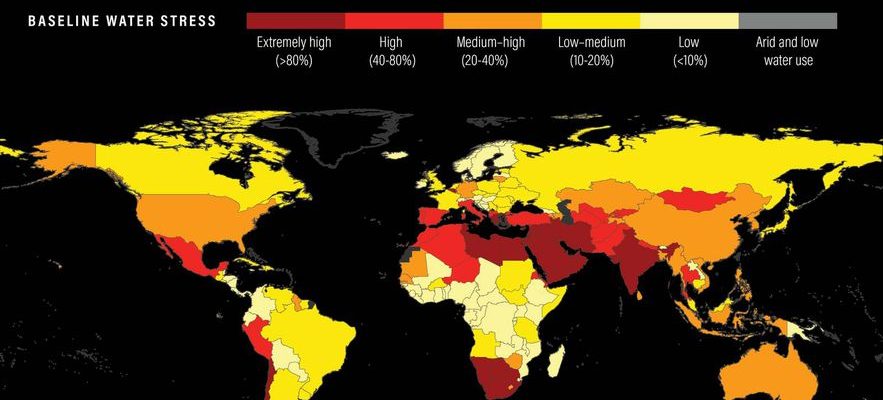It is a sad fresco of the state of water resources in the world. On Wednesday August 16, the environmental NGO World Resources Institute (WRI) updated its “Aqueduct” report on the lack of access to water in the world. A fourth version still based on publicly available data, in particular formatted with an interactive map.
The WRI also formulates conclusions based on its new dataset: according to the organization, 25 countries, representing “a quarter of the world’s population, are currently exposed to extremely high water stress each year”, specifies the technical note that accompanies the report.
Four European countries among the 25 most affected
In concrete terms, the 25 countries concerned face “extremely high water stress every year”, indicates the “Aqueduct” report: they thus consume more than 80% of their renewable water resources in one year. In the WRI country rankingthe five most affected countries are all close to or located in the Middle East: Bahrain, Cyprus, Kuwait, Lebanon and Oman.
Geographical areas where “even a short drought could pose a risk of water shortage”, notes the American channel CNN. Although these countries are relatively sparsely populated, India’s presence in 25th place partly explains the demographic weight of the report’s conclusions.
Closed captioning: A quarter of the world’s population faces extreme water stress, according to the World Resources Institute’s 4th report.
© / World Resources Institute
The Asian continent represents the majority of countries facing extreme water scarcity in the WRI list. Nevertheless, four European countries are also concerned: in addition to Cyprus, the small Republic of San Marino, Greece and Belgium are also affected by the phenomenon. In question for the latter, “industrial demand, which represents nearly 90% of all water needs”, justifies with the newspaper Release the report’s data manager, Samantha Kuzma.
Beyond these 25 countries in an emergency situation, the WRI also specifies that approximately “4 billion people, or half of the world’s population”, must also face water stress for at least one month each year. .
A situation that is expected to worsen by 2050
Although the situation in France is not classified as critical, it is not without risk in the future. On July 17, the Court of Auditors published a report calling for reducing water withdrawals at the national level, in the face of the challenges of global warming. As AFP reminds us, the quantity of renewable water available in mainland France fell by 14% between the period 1990-2001 and 2002-2018 due to rising temperatures.
“It is through water that climate change most directly affects people around the world,” Charles Iceland, director of water at WRI’s “Food, Forests, Water and Oceans” program, told CNN. Demand is also expected to increase by 20-25% by 2050, the report says.
Similarly, the organization estimates that the proportion of countries affected by water consumption above 80% of its renewable resources could reach 60% by the same date. “As soon as you look at sub-Saharan Africa, you see the demand for water skyrocketing,” Samantha Kuzma told CNN.
A crisis linked to all the others
For the WRI, the need to ensure access to water is therefore as much about our personal water consumption as our ability to “feed a growing population” or “achieve global climate goals”. Water stress should also impact the economic resources of the States most concerned. The WRI estimates that “70,000 billion dollars of GDP” should be called into question by this phenomenon by 2050. India, Mexico, Egypt and Turkey alone represent more than half of these resources, according to the “Aqueduct” report.
The NGO calls for a change in our “way of managing water”. Among the solutions cited in the report: “The preservation and restoration of wetlands and forests, the adoption by farmers of more efficient watering techniques, such as drip irrigation, and that Policymakers are focusing on energy sources that aren’t as water-dependent, such as solar and wind,” CNN said. Concrete tracks that will have to be put in place before the water crisis causes international tensions.
